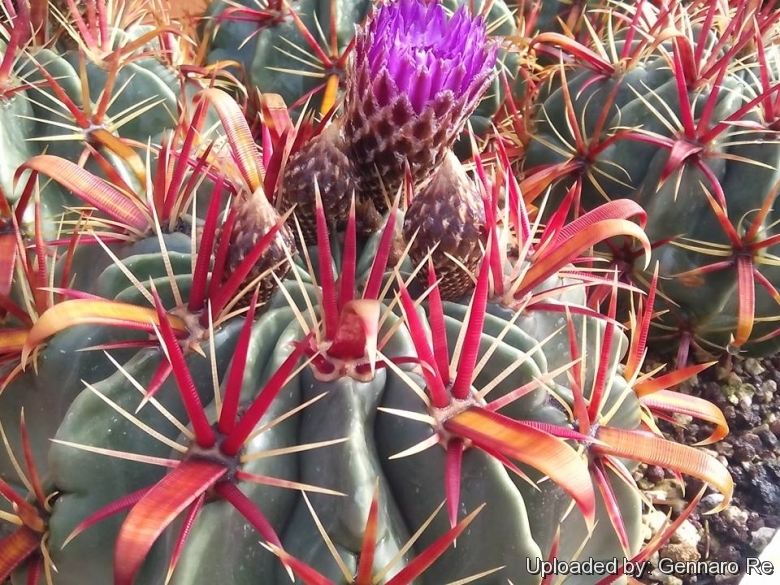
Ferocactus latispinus Photo by: Gennaro Re
Origin and Habitat: This species has an extensive distribution in central and southern Mexico ( Durango, through Zacatecas, Aguascalientes, east to the western parts of San Luis Potosí, Hidalgo and Puebla, as well as to eastern Jalisco, Guanajuato, Querétaro and Mexico State. ). This cactus has widespread and abundant subpopulations.
Altitude range: This species grows at elevations of 600 to 2,600 metres above sea level.
Habitat: Ferocactus latispinusSN|4300]]SN|4259]] is common in dryer areas and grasslands of central Mexico and in a variety of xerophyllous scrub types, grassland, and open Quercus forest (in Oaxaca) where it is usually found growing on silty flats and plains. It may also occur on rocky hillsides. The range of this species is north of that of closely related Ferocactus latispinusSN|4280]]SN|4259]] ssp. spiralis (syn. Ferocactus recurvusSN|4259]]SN|4280]]). It grows in association with other plant species, including: Echinocactus horizonthaloniusSN|10367]]SN|1711]], Coryphantha clavaSN|3941]]SN|3896]], Coryphantha pallidaSN|10262]]SN|10262]], Stenocereus marginatusSN|8042]]SN|8042]], Echinocereus cinerascensSN|7775]]SN|7775]], Ferocactus histrixSN|4259]]SN|4300]], Hechtia podanthaSN|19012]]SN|19012]], Agave salmianaSN|540]]SN|27883]], Agave kerchoveiSN|247]]SN|293]], Agave parryiSN|293]]SN|247]], Agave potatorumSN|27883]]SN|540]], Myrtillocactus geometrizansSN|8050]]SN|8050]], Opuntia scheeri, Opuntia imbricata, Opuntia lasiacantha, Opuntia spinulifera, Opuntia robusta, Coryphantha erectaSN|3896]]SN|3941]], Echinofossulocactus anfractuosusSN|6199]]SN|6199]], Neolloydia conoideaSN|10089]]SN|10089]], Echinocactus platyacanthusSN|1711]]SN|10367]], Heliabravoa chendeSN|7732]]SN|7732]], Echeveria secundaSN|27133]]SN|27133]], Jatropha spathulata, Schinus molle, Arbutus glandulosa, Dodonaea viscosa, Selaginella lepidophylla, Dasylirion acrotrichumSN|2998]]SN|2998]] and Yucca filifera. Goats disperse viable seeds of this and other species. Local collecting for national ornamental plant trade affects subpopulations near villages and towns. Livestock and goats degrade the vegetation where this species occurs. The plants are collected locally for medicinal use and consumed raw or as a candy.
Synonyms:
See all synonyms of Ferocactus latispinus
back
Accepted name in llifle Database:Ferocactus latispinus Britton & RoseCactaceae (Britton & Rose) 3: 143. 1922 [12 Oct 1922]Synonymy: 26
Accepted name in llifle Database:Ferocactus latispinus subs. spiralis (Karw. ex Pfeiff.) N.P.TaylorCactaceae Consensus Init. 5: 13. 1998Synonymy: 15
back
Common Names include:
ENGLISH: Devil's Tongue Barrel, Crow's Claw Cactus, Candy cactus
CZECH (Čeština): Ďáblův jazyk
LITHUANIAN (Lietuvių): Plačiadyglis ferokaktusas
SPANISH (Español): Pochas (referring to the fruits)
SWEDISH (Svenska): Djävulstunga
Description: Ferocactus latispinusSN|4280]]SN|4259]] is a modest-sized barrel cactus and probably the best-known of the ferocacti, and if you want only one from this group, this is the one to choose. Three subspecies are recognized, the nominate form and subsp. greenwoodii (Glass) N.P.Taylor and subsp. spiralis (Karw. ex Pfeiff.) N.P.Taylor.
Habit: It is a perennial stem succulent, which normally remains a solitary plant, without dividing or producing offsets.
Stem: Light green to blue-green, hemispherical or flat-topped, 25 to 45 cm in diameter, 10-35(-40) cm tall, most often wider than tall.
Ribs: 13 to 23 ribs (but usually 21), sharp and prominent.
Areoles: Large on bumps along the ribs with grey to blackish felt.
Radial spines: (6-)9-12(-15) up to 2,5 cm long, spreading out, smaller, annulate, finely needle-like, straight that have almost no width at all, translucent white, yellow, pink or reddish.
Central spines: 4 (or more) large, transversely striated, more highly coloured than radials of which the lowest one is conspicuously wider, thick and flat (4-9 mm broad), up to 4(-7,5) cm long apically bent downward or hooked and lie flat against the body (near straight in Ferocactus latispinusSN|4259]]SN|4259]] var. greenwoody). This prominent spine is usually red or grey-red, but may be amber-coloured or yellow (Ferocactus latispinusSN|4259]]SN|4259]]var. flavispinus). The other central spines are still stout, but much narrower and not curved.
Flowers: Campanulate, beautiful “glassy” rich-rose, purple, mauve, purple-blue or, sometime, straw-yellow, and fragrant up to 2,5-3,5(-6) cm long and about 3 cm broad. Perianth segments narrowly oblong, acute. Scales on the ovary closely imbricated, thin and papery, ovate with thin ciliate margins. Scales on flower tube similar similar to those on the ovary but longer.
Blooming time: Late autumn to early winter, usually in October, but it usually flowers only if the weather is warm and sunny ( need a fair amount of bright sunlight to form) Unlike most of the others, which usually need to reach relatively large size this species blooms very early, many young plants will bloom when they reach only 10 cm in diameter. It might be noted that this is not true of the closely related Ferocactus latispinusSN|4259]]SN|4259]] ssp. spiralis (syn. Ferocactus recurvusSN|4259]]SN|4280]]);
Fruit: Sperical to elongate about 2,5-8 cm long. 1,8-2,5 cm broad, clothed in tapering scales.
Seeds: Dark-brown, reniform, slightly pitted, 1,2-1,5 mm long.
Notes: This species usually flowers only if the weather is warm and sunny ( need a fair amount of bright sunlight to form) It blooms very early, many young plants will bloom when they reach 10 cm in diameter.
Bibliography: Major references and further lectures
1) Edward Anderson “The Cactus family” Timber Press, Incorporated, 2001
2) James Cullen, Sabina G. Knees, H. Suzanne Cubey "The European Garden Flora Flowering Plants: A Manual for the Identification of Plants Cultivated in Europe, Both Out-of-Doors and Under Glass" Cambridge University Press, 11/Aug/2011
3) David R Hunt; Nigel P Taylor; Graham Charles; International Cactaceae Systematics Group. "The New Cactus Lexicon" dh books, 2006
4) N. L. Britton, J. N. Rose “The Cactaceae. Descriptions and Illustrations of Plants of the Cactus Family” Volume II, The Carnegie Institution of Washington, Washington 1920
5) George Edmund Lindsay, J. Hugo Cota “The taxonomy and ecology of the genus Ferocactus: explorations in the USA and Mexico” Tireless Termites Press, 1996
6)
7) Curt Backeberg “Die Cactaceae, Handbuch der Kakteenkunde:Volume 5, Cereoideae (Boreocactinae)” 1961
8) Hiroshi Hirao “Colour encyclopaedia of cacti” Seibundo Shinkosha, 1979
9) Willy, Cullmann Erich Götz, Gerhard Gröner: Kakteen: Kultur, Vermehrung und Pflege. Lexikon der Gattungen und Arten. Ulmer, Stuttgart edn 5.1984
10) William Davidson “The illustrated directory of house plants: a practical guide to growing over 500 plants for the home” Salamander, 01/Nov/1990
11) Michael Taborsky, Barbara Taborsky “Advances in Ethology”, Volume 32 Parey, 1997
12) Brian Lamb “Letts guide to cacti of the world” Letts, 17/Oct/1991
13) Sánchez , E., Guadalupe Martínez, J., Bárcenas Luna, R., Hernández, H.M., Gómez-Hinostrosa, C. & Cházaro, M. 2013. Ferocactus latispinus. The IUCN Red List of Threatened Species 2013: e.T151750A557418. http://dx.doi.org/10.2305/IUCN.UK.2013-1.RLTS.T151750A557418.en. Downloaded on 25 April 2016.
14) Arias, M.S., Gama, S. and Guzmán, U. 1997. Flora del Valle de Tehuacán-Cuicatlán. Fasículo 14. Cactaceae A.L. Juss. Instituto de Biología, UNAM, Mexico.
15) Baraza, E. & A. Valiente-Banuet. “Seed dispersal by domestic goats in a semiarid thornscrub of Mexico.” Journal of Arid Environments 72: 1973-1976. 2008.
16) Canales-Martínez, M., T. Hernández-Delgado, J. Caballero-Nieto, A. Romo de Vivar-Romo, A. Durán-Díaz, R. Lira-Saade. “Análisis cuantitativo del conocimiento tradicional de las plantas medicinales de San Rafael, Coxcatlán, Valle de Tehuacán-Cuicatlán, México.” Acta Botánica Mexicana 75: 21-24. 2006
17) González-Insuasti, S. & J. Caballero. “Managing plant resources: how intensive can it be?” Human Ecology 35: 303-314. 2007
18) Hernández, H.M., Gómez-Hinostrosa, C. and Goettsch, B. “Checklist of Chihuahuan Desert Cactaceae.” Harvard Papers in Botany 9(1): 51-68. 2004
19) Méndez-Larios, I., Lira, R., Godínez-Alvarez, H., Dávila, P. and Ortiz, E. “Proposal for the establishment of the core zones in the Biosphere Reserve of Tehuacán-Cuicatlán, Mexico.” Biodiversity and Conservation 15: 1627-1659. 2006
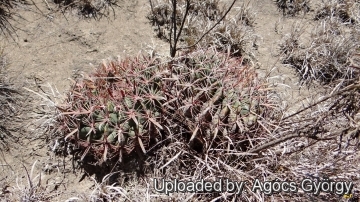 In habitat. Mexico. Photo by: Agócs György
In habitat. Mexico. Photo by: Agócs György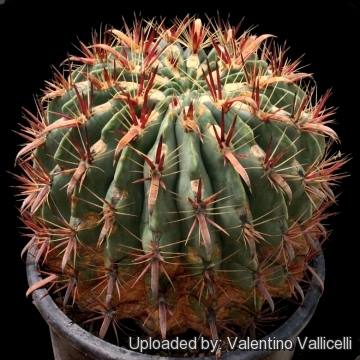 - It is a beautiful members of the genus Ferocactus and is commonly called barrel cactus, it is fairly popular in cultivation because it blooms very early. The young spines have a great looking red. Photo by: Valentino Vallicelli
- It is a beautiful members of the genus Ferocactus and is commonly called barrel cactus, it is fairly popular in cultivation because it blooms very early. The young spines have a great looking red. Photo by: Valentino Vallicelli Ferocactus latispinus Photo by: Frikkie Hall
Ferocactus latispinus Photo by: Frikkie Hall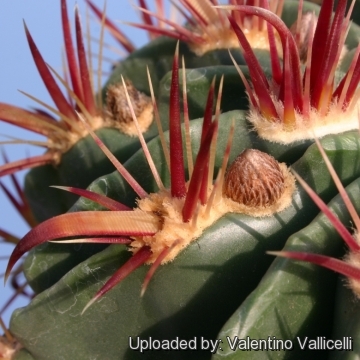 Ferocactus latispinus Photo by: Valentino Vallicelli
Ferocactus latispinus Photo by: Valentino Vallicelli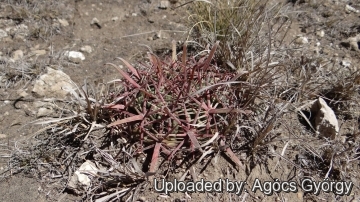 Ferocactus latispinus Photo by: Agócs György
Ferocactus latispinus Photo by: Agócs György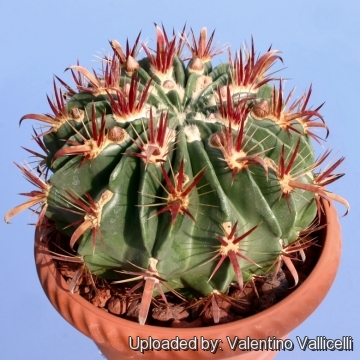 Ferocactus latispinus Photo by: Valentino Vallicelli
Ferocactus latispinus Photo by: Valentino Vallicelli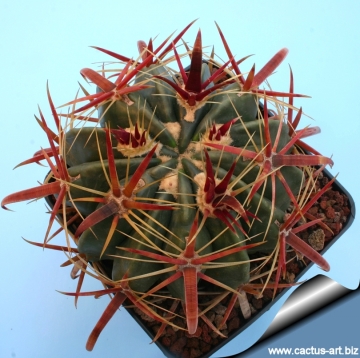 Ferocactus latispinus Photo by: Cactus Art
Ferocactus latispinus Photo by: Cactus Art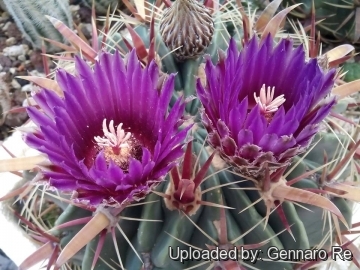 Ferocactus latispinus Photo by: Gennaro Re
Ferocactus latispinus Photo by: Gennaro ReCultivation and Propagation: Ferocactus latispinusSN|4259]]SN|4259]] is a relatively easy species. Slow growing to start but does well under cultivation.
Growth rate: TSlow growing to start but does well under cultivation.
Soil: Grow it in a rich and particularly draining substratum, as it is very sensitive to rottenness when in presence of humidity and low temperatures and let the soil dry out between waterings.
Repotting: Repot in the spring, when their roots become cramped. Generally, they should be repotted every other year in order to provide fresh soil. After repotting, do not water for a week or more. Use pot with good drainage.
Fertilization: It grows much faster with a low nitrogen content fertilizer in spring and summer.
Watering: Water during the aestival growth cycle from March till October, the thin, fibrous roots suffer if there is humidity, therefore the plant should be watered only when the surrounding terrain is dry. But needs to be avoided wetting the bodies of these plants while they are in sunlight. A wet cactus in the sun light can cause sun burning which can lead to scars or even fungal infections and death. Keep dry as soon as the temperature starts dropping in October and keep it perfectly dry in winter at temperatures from 5 to 15 degrees centigrade. Preferable not to water on overcast days, humid days or cold winter days.
Hardiness: They need to be kept in a cool place during winter rest and can tolerate sporadic light frost if kept on the dry side prior to, and during, cold weather with little danger of being killed. However in cultivation it is better not to expose it to temperatures lower than 5° C, even if in an aerated and protected location. It tends to rot in winter during the resting phase, if kept wet. In the rest period no high atmospheric humidity!! Outdoors this plant is very adaptable, as long as you avoid excessive humidity in the winter months.
Sun Exposure: It need full sun exposures with ample airflow for best appearance.
Uses: The "Candy cactus" is used to make sweets. The middle is cored out and soaked in sugar, then chopped up and eaten.
Warning: The spines that hook around can grab you if you get too close.
Pests & diseases: It may be attractive to a variety of insects, but plants in good condition should be nearly pest-free, particularly if they are grown in a mineral potting-mix, with good exposure and ventilation. Nonetheless, there are several pests to watch for:
- Red spiders: Red spiders may be effectively rubbed up by watering the infested plants from above.
- Mealy bugs: Mealy bugs occasionally develop aerial into the new growth among the wool with disfiguring results, but the worst types develop underground on the roots and are invisible except by their effects.
- Scales: Scales are rarely a problem.
- Rot: Rot is only a minor problem with cacti if the plants are watered and “aired” correctly. If they are not, fungicides won't help all that much. To prevent rottenness it is also advisable to surround its root neck by very rough sand or grit, this help a fast water drainage.
Propagation: Almost exclusively by seed. The seeds can be sown in pots of fine, well-drained sandy soil, any time during the spring when temperatures are warm. The seedlings should not be disturbed until they are well rooted after which they can be planted separately in small pots.
Your Photos

by Agócs György




















